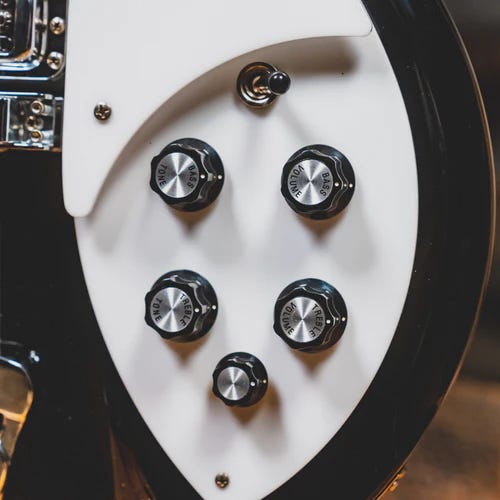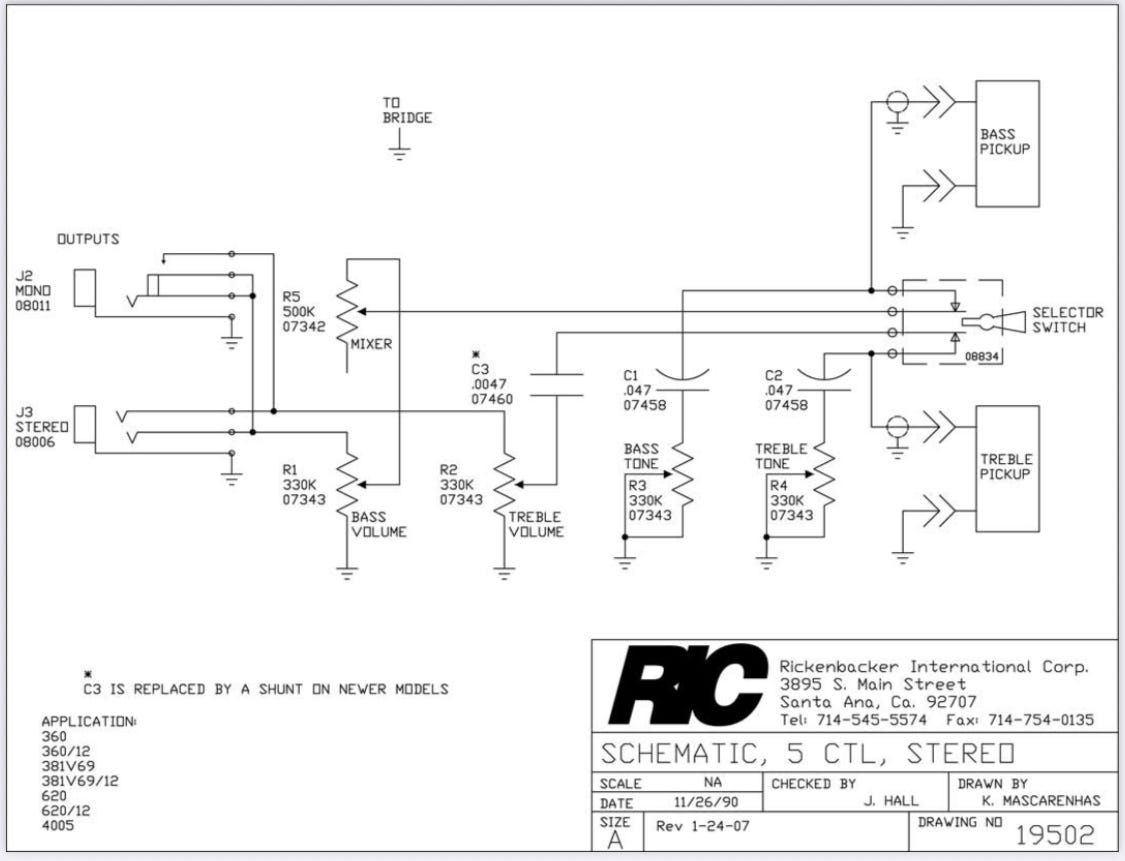Terminology: The Fifth Knob

“What does that fifth knob ACTUALLY do?” It’s probably the single most asked question about Rickenbacker guitars. Many have tried to explain it simply, and many have failed. Do I think I will be the one who finally makes it all clear? Certainly not. But I’m going to try anyway!
But let’s start with what the owner’s manual says:
Many Rickenbacker guitars and basses come with a fifth control knob providing extra tone adjustment capabilities. Using this control to adjust the volume of the bass pickup in relation to a preselected treble pickup lead volume setting, you can set it at the tone you will use more often. Or it can function as bass/treble equalization control.
To use the fifth knob as a bass pickup volume equalizer, first place both volume and both tone controls on the instrument at their maximum clockwise positions. Then, move the pickup selector to the treble position and set the amplifier to the desired lead sound. Now, switch the pickup selector to the bass pick up. The fifth tone knob can now be adjusted in order to bring the rhythm sound to a volume compatible with the already selected lead sound volume.
To use the fifth knob in a set position, first place both volume controls and both tone controls on the instrument at their maximum clockwise positions, and move the pickup selector to the center position. Now, adjust the amplifier, by setting the gain controls at the desired volume and the bass and the treble controls at their maximum positions. Finally, adjust the fine tone selection knob on the instrument until the tone which will be used most frequently is reached, and leave it in that position. After the small knob has been set, the pickup selector may be moved down for maximum treble or up for maximum bass. The variable volume and tone controls on either the amplifier or the instrument can now be moved to the desired volume and tone settings.
To use the fifth knob as an equalization control, first place both volume controls and the treble tone control on the instrument at their maximum clockwise positions, and move the pickup selector to the center position. Move the bass tone control on the instrument to its maximum counterclockwise positions, and set the volume and tone controls on the amplifier to their desired positions. Now, with the instrument's treble up full and the bass at its minimum, the fine tone selection knob can be used as a tone equalizer, moving the instrument through the entire tonal range without adjusting the amplifier.
If that’s perfectly clear to you, no need to go any further! Me…I bet I’ve read that a hundred times, and it’s still not clear. Forget about all that. Let’s start with HOW it works…that might make WHAT it does clearer.

Don’t worry, I don’t speak electrical engineer either! Let’s put it into plain English. We’ll start with the bridge pickup. The lead from the pickup goes to the three way switch. It then gets split, with outputs going to the tone pot and the volume pot. Easy enough so far, right?
On its way to the tone pot, it passes through a .047µF capacitor. This capacitor is a “low pass filter”—it allows the “lows” to pass through, and sends the “highs” and “mids” to ground. How much of those highs and mids get bled off is controlled by the tone knob—the lower you turn it, the more you roll off. So far, exactly as you’d expect.
On post 1984 guitars, the volume output goes straight from the three way switch to the volume pot. Pre-1984 guitars were equipped with the “vintage tone circuit”—a .0047µF capacitor. This capacitor was a HIGH pass filter, allowing highs to pass through and sending the mids and lows to ground. The end result is that the bridge pickup output on pre-1984 guitars is noticeably lower than the neck pickup—and quite a bit brighter to boot—meaning that the mystery fifth knob is actually much more useful on these earlier guitars.
OK, we’ve explained two of five knobs in plain language, and hinted at the fifth knob’s purpose! Now let’s move to the neck pickup. Just like the bridge pickup, the pickup lead goes to the three way switch and is split. And, identical to the bridge pickup, the tone output goes to a a .047µF capacitor and thence the tone knob. The neck pickup volume output is where things get interesting because it goes to…the fifth knob! And from there to the neck pickup volume knob? Making the fifth knob a…volume knob for the neck pickup volume knob?
Basically, yes. A pre-volume knob, if you will! Only it works in reverse. When you dime it, it reduces the output of the pickup—but because it’s not grounded like a “normal” volume pot is it doesn’t reduce it all the way—and when you roll it all the way off the neck volume knob acts like it would if the fifth knob weren’t there at all.
So with that in mind, let’s go back to the three use cases called out in the owners manual. Use case number one is a pickup output equalizer. Basically you dime the volume on both, then switch back and forth between the pickups to A/B them and use the fifth knob to get an equal output on both. Then never touch it again. Again, this was MUCH more useful on older guitars where the output disparity was quite significant between the two pickups.
Use case number two is to dial in your favorite blend and then “set it and forget it”. Put the pickup selector in the middle position and use the fifth knob to tweak the mix to your liking. Then never touch it again.
Use case number three is to use it as a fine tuner to adjust the pickup mix (and therefore the tone) on the fly. Nobody does this, by the way.
And if I haven’t made it clear, if you select only the bridge pickup it does nothing because it only impacts the neck pickup output. It only “does something”in the neck and middle positions.
Could you do all of these things with just four knobs? Absolutely. Really, it’s kinda obsolete these days. John Hall has said he would delete it if he didn’t know the villagers would come for him with torches and pitchforks. But we would, and so it remains.
So what does the fifth knob do? My contribution to the many attempts to explain it is to call it a pre-volume knob volume knob for the neck pickup. If that helps you understand it…great! If not, I welcome a better explanation!
Want to learn more about…everything else? Check out the rickenbacker101 site map and see what’s already been covered! Have a suggestion about what we should tackle next? Drop it in the comments and we’ll add it to the queue.

